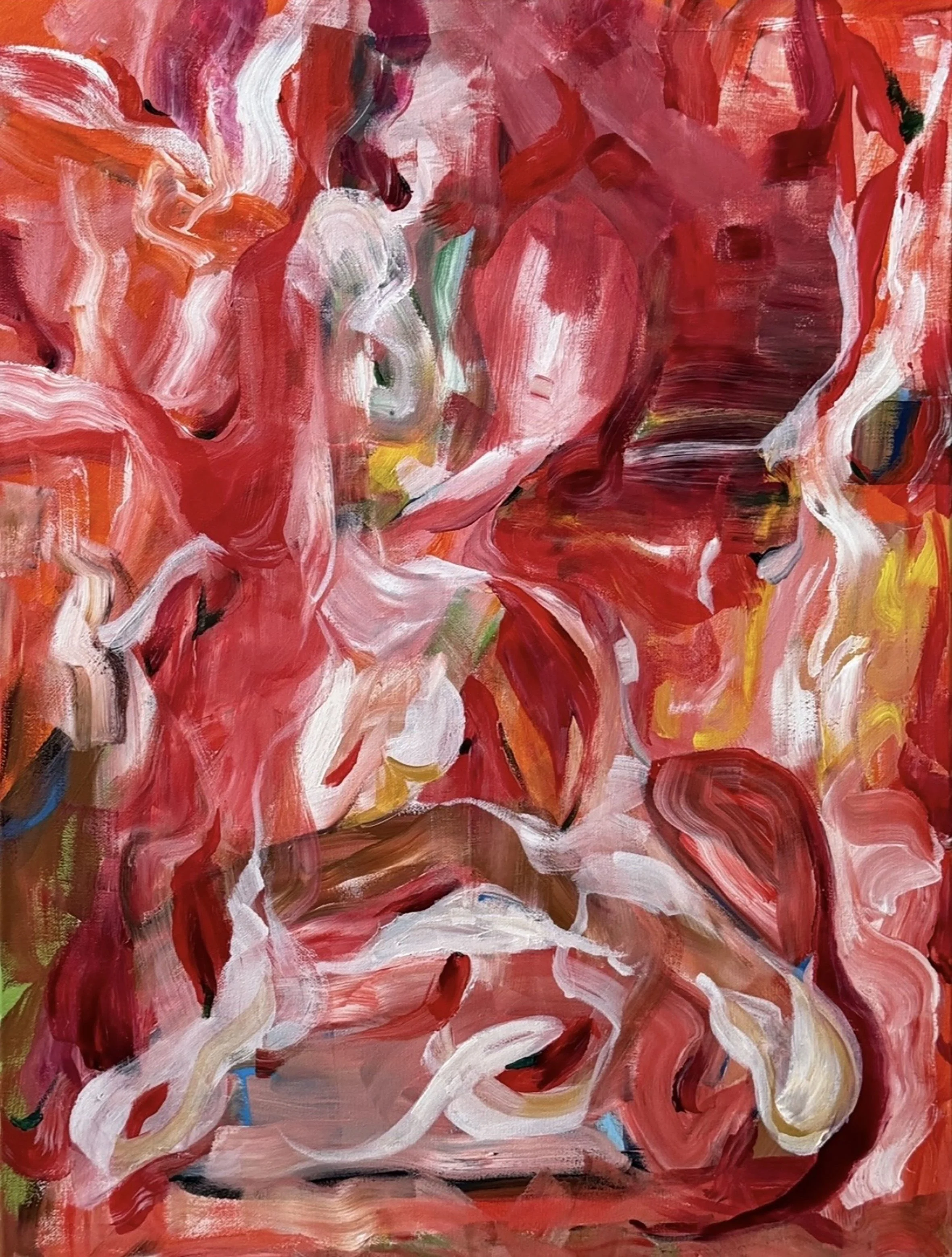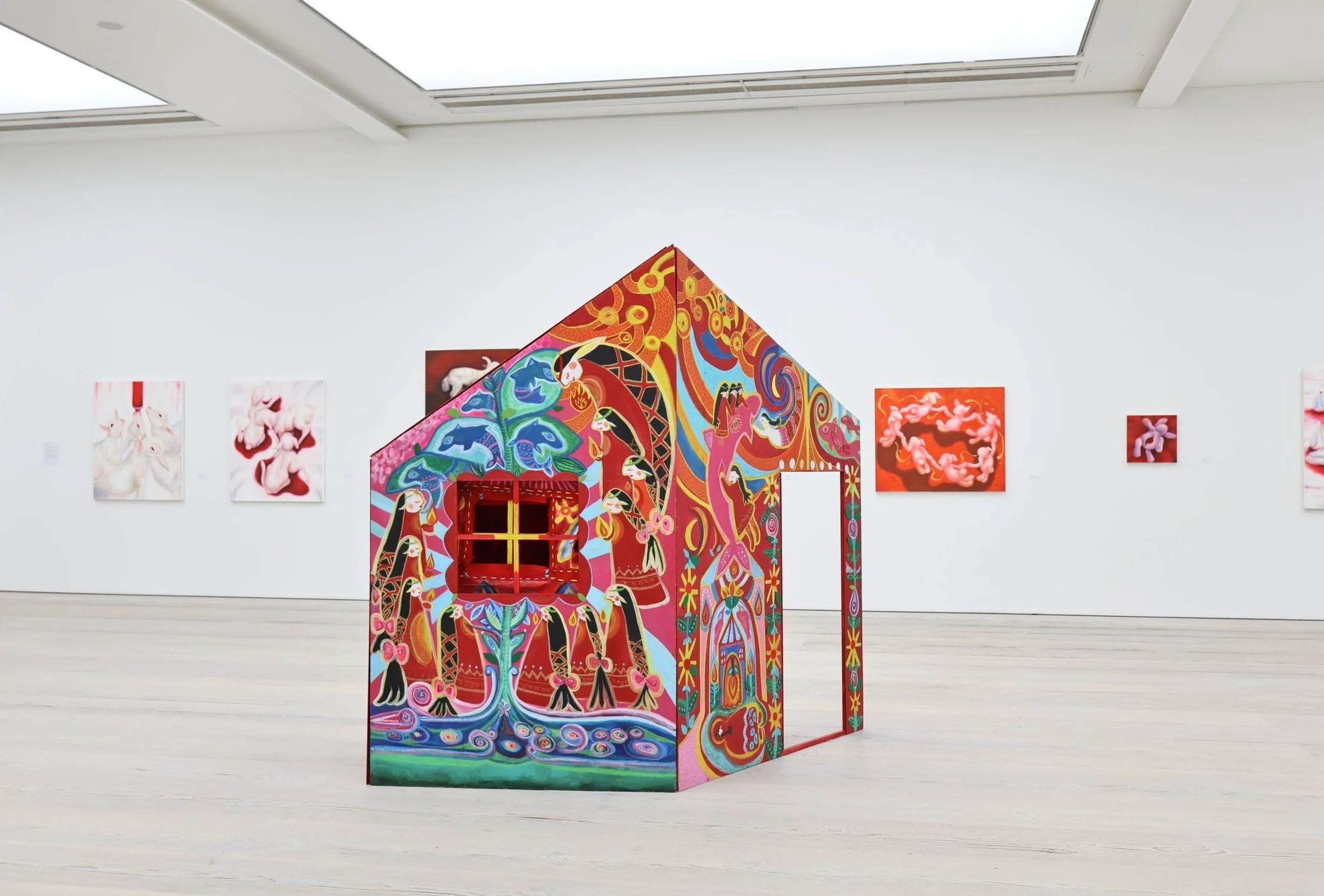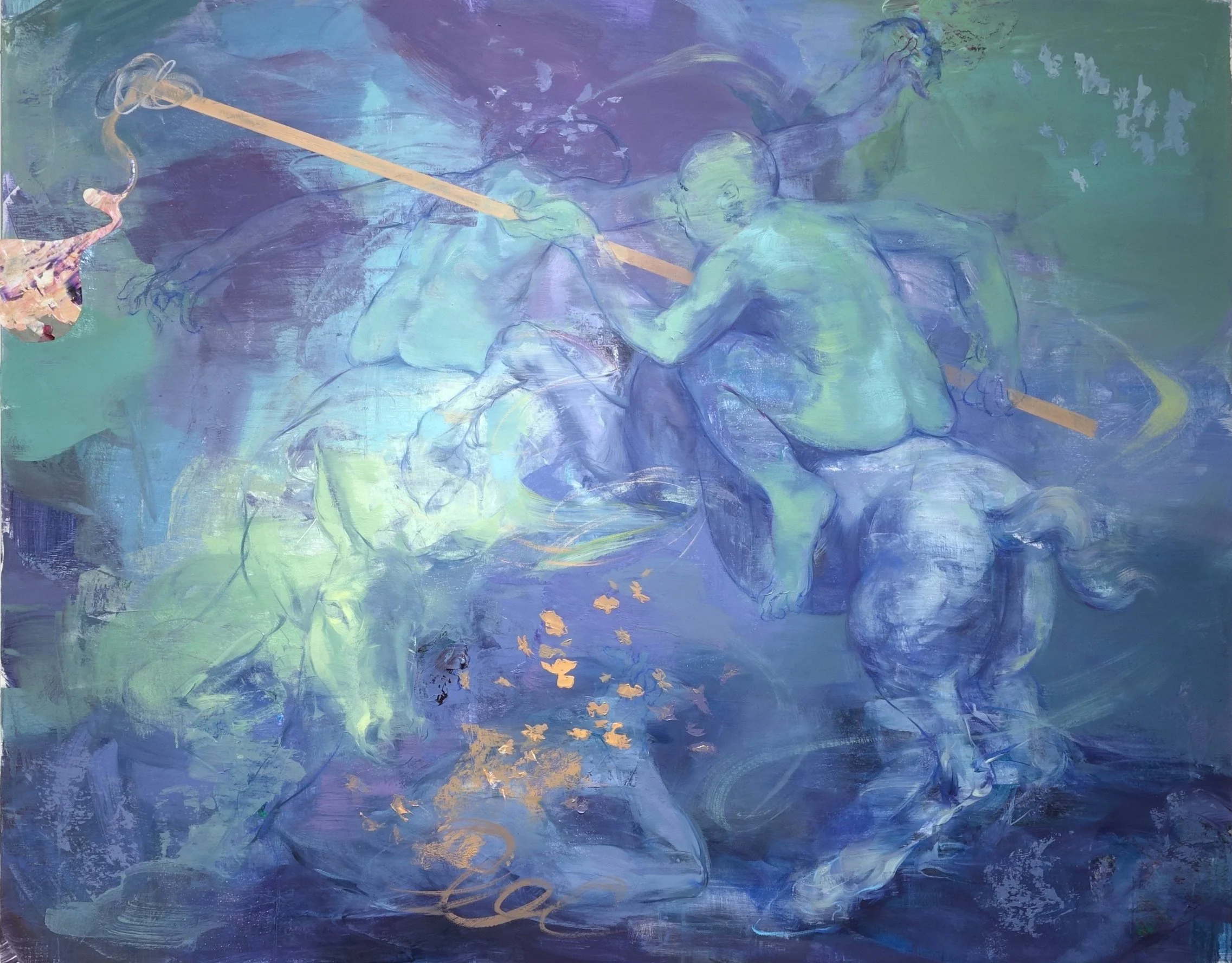10 Questions with Maria Petroff
Al-Tiba9 Art Magazine ISSUE14 | Featured Artist
Maria Petroff is a self-taught figurative artist living between two countries: Russia and Canada. Originally from Moscow, Maria moved to Canada in 2009 to study Business Administration at the University of Quebec in Montreal. The artistic flair of the «North American Montmartre» inspired the future artist to get back to her childhood passion - painting. Shortly after finishing her studies, Maria decided to pursue a career in art.
Maria defines her artistic style as critical realism. She likes to paint people who marked our history, whether they are politicians, scientists, artists, philosophers, or fictional characters. The artist gets inspired by today’s world events, trying to thoroughly study the other non-official side of the story. Digging deep into history makes her come up with subjects for paintings that depict long-forgotten historical events and draw parallels with the present. Spiced up with light humor, her works address contemporary social and political issues.
Maria takes an active part in international art contests and exhibitions. The artist created book covers for a renowned author and economist, V. Katasonov. Recently one of her paintings was featured in the Swiss weekly magazine Die Weltwoche.
She creates works that draw a parallel between the past and the present. History has a tendency to repeat itself. And since we forget the past, we are condemned to relive it. Being an artist who lives in times of change, Maria set herself a goal «to immortalize» important historical figures and events that marked our life in one way or another.
Maria Petroff - Portrait
Project Statement
It’s no secret that the capitalist economic system is no longer viable. While some reflect on whether there is a future without capitalism, others believe that we have already entered the era of post-capitalism. Indeed, the economy based on financial speculations and uncontrollable printing of money proved to be ineffective and led to greater global inequality. The world needs change. The leaders of the World Economic Forum came up with the solution - to build an economy that works for everyone - inclusive capitalism. A previously unknown concept raises questions about what it really implies. The aim of the artist’s project is to show a critical view of the changes happening globally regardless of any political and cultural turmoil that we experience at this time.
Art Basel 2030. Installation Fast Fish, oil on canvas, 100x80 cm, 2023 © Maria Petroff
Limited edition magazine >>
INTERVIEW
First, let's talk about your background. Could you tell us more about yourself and how you began making art?
Originally I come from a small Russian town 30 kilometers from Moscow called Pushkino. For as long as I can remember, I've always been very creative and also curious. Being raised in the 90s, I have witnessed all the consequences of «perestroika» ( the program that was implemented in the Soviet Union in the mid-1980s to restructure its economic and political system). Of course, as a kid, I couldn't comprehend the gravity of the situation (that is, the economic crisis, the migration crisis, rising poverty, extreme crime level, etc.) that our country was facing. But I could see how the infrastructure in my hometown was falling into decay. And I genuinely couldn't understand why nothing was being done to fix that. That's how I've always been asking simple childish questions, and without receiving clear answers, I searched for my own solutions. Thus, I was drawing the renovation sketch plans of my school and then my neighborhood. I was trying to decorate the ugly walls of my school with my drawings of Disney characters, portraits of Russian poets and writers. I even had bigger plans to rebuild the entire town.
I truly believe that artists are born, not made. And the artists' main intention is to make this world a better place. That's exactly what I was trying to do as a child. Unfortunately or fortunately, I didn't realize back then that I was destined to become an artist.
Art Basel 2020, oil on canvas, 100x80 cm, 2021 © Maria Petroff
You are a self-taught artist, and you originally studied Business Administration. When did you decide to become an artist? And what do you wish you knew about contemporary art before you got started?
Like I said, I regret, and at the same time, I don't regret not pursuing an art career from the beginning. After school, I enrolled at the Moscow State University of International Relations to study Business Administration thinking that obtaining knowledge in this field together with a Masters's degree from the prestigious University would be beneficial to me. But it wasn't. The studies were boring, extremely theoretical, and sometimes even misleading. But the experience wasn't in vain. Little did I know that it would influence my art immensely. In 2009 I went to Canada to continue my studies in the same field at the University of Quebec in Montreal. Living in this vibrant Canadian city full of art and artists inspired me to do what I've always liked to do - to create. However, I had no intention of getting another degree or taking any art classes because of all the rules and restrictions the education system imposes on students. I was afraid it would kill my creative impulse since I heard such stories from some former art students. I wanted to figure it out on my own - to find my unique artistic style, to find out if my art is needed or «marketable,» and most importantly, what message I want to convey through my art. And the latter took me a while.
I remember I was traveling from Montreal to visit my parents in Russia, and as always, I took a flight with a stop in Amsterdam. There was this bookstore in Schiphol airport I liked to go to. And this time, instead of buying some entertaining fiction novel, I picked the book by former US Secretary Henry Kissinger, «World Order.» After reading the book and learning more about the author, I felt this urge to paint him as the first proclaimed Russian Tzar Ivan the Terrible. This painting is one of my favorites and is hanging in my bedroom as a reminder for me to stay loyal to my artistic style and goal no matter what others think. Unfortunately, like any other artist, I was hesitant for quite a while until I finally received my first recognition. I contacted a renowned Russian economist and writer, V. Katasonov, and offered to illustrate some of his articles on his website. Instead, he picked one of my paintings that he really liked and asked for the cover of his new book. That's the exact moment I realized that I did everything right and that I should continue going in that direction. And right at the same time, my first painting was sold, and my other painting was published in the Swiss weekly magazine Die Weltwoche, and thus my journey began.
Before I got started, I wish I knew, and I actually very soon realized that contemporary art was not just a commodity traded on a highly competitive market. Contemporary art is supposed to transfer a message, especially in the times of change we live in. An American economist Jeremy Rifkin once said that artists are like «canaries in the mine»; they can signal various changes happening to us. He believes that artists play a major, consciousness-raising role in defining issues of our time. I totally agree with that statement, although the issues I see are different from what Rifkin and many others want us to see.
Let's talk about your creative process. Where do you draw inspiration from nowadays?
I've already touched on how I come up with the ideas for my paintings. I feel this strong urge to paint a certain persona or a scene while reading or studying a particular socioeconomic topic. And then, I transfer this image in my head into Photoshop on my computer and then use it as a reference image to create a realistic oil painting on canvas.
Nowadays, living in a rapidly changing world, I never lack ideas for my paintings. All I lack is time on a 24-hour day. I set myself a goal to paint as many historical figures and events as I can, and while we still can. In the future, art will be ephemeral, and people will enjoy it in a particular moment for a short period of time. It fits in perfectly with the notion of the digital world. While physical art is immortal and can speak louder than words, my art, in particular, speaks about the New World they are building, its ideologists and creators, and what preceded its creation.
Anatomy Lesson of Dr. Schwab, oil on canvas, 100x80 cm, 2023 © Maria Petroff
What is your artistic routine when working? Do you have a set schedule, or do you work following your inspiration?
I work every day. However, I do not have a set schedule. I am just trying to spend as much time as I can in my studio. I prefer to work on several paintings at a time. It helps me stay motivated, especially when a painting is very detailed. Once I get tired of it, I switch to another one for a day or two and then get back to it again. I try to finish all my paintings. It happens very rarely that I don't finish a painting, only if I get distracted by a more relevant idea of a painting.
With your latest series of paintings, you reflect on capitalist society and how it is deeply unequal and problematic. What prompted you to reflect on this concept?
The past three years showed that the world entered the post-capitalist era. It might have entered even earlier, but we just noticed it. I wanted to figure out what was wrong with the capitalist society that faced this urgent need to build a New World. Or was it meant to be this way in order to be replaced by a different economic system? Capitalism is flawed by its nature. However, today almost every economy in the world is organized along capitalist lines. From what I see, the flaws of capitalism play into the hands of those who implement the new social and economic system. Simple example: one of the greatest sins we as people are accused of is excessive consumerism. Indeed, the more we consume, the more our planet suffers, the bigger the impact is on the environment. Nobody doubts that. However, all the responsibility is put on the end consumers, i.e., us, ordinary people. At my University, they taught us Keynes' Law that states: «demand creates its own supply,» while, in fact, it's quite the opposite. Big companies owned by the big financial institutions use all the possible marketing tools to make people purchase more goods that they don't even need. Because the main goal of a company operating in the capitalist market is to gain more profit, Capitalism is an extensively growing economic system, and the fall in demand will inevitably lead to an economic recession. It's a vicious circle, and the end consumer is in the center of it, taking all the blame. Thus, the ideologists of the new economic system (the one that they call «inclusive capitalism») came up with the solution for us to cut consumption to the point that in the future, «we will own nothing, and we will be happy.» It turns out that we've been duped all this time, and now where is the guarantee that it won't happen again?
Dance Around the Golden Calf, oil on canvas, 80x60 cm, 2023 © Maria Petroff
Under the Skin, oil on canvas, 80x60 cm, 2022 © Maria Petroff
You paint primarily people, whether real or fictional, and in the series, you depict them in surreal situations, from science labs to art fairs. What do you want to communicate to the public with this series?
With this series, I want people to reflect on the topics that are not making the first headlines of major newspapers. Though they are not completely hidden from the public, most people tend not to notice them or consider them not important. They «can't see the forest for the trees,» meaning that they refuse to see the larger picture paying attention to the particular minor details. I think that recently people have more than ever been «entertained» by all those political quarrels, by «who said what to who» and other distracting events while the New World is being built. I want people to start questioning all the initiatives that we've been offered lately because most of them are quite controversial. Things like brain chip trials, the creation of artificial wombs, and the introduction of insect-based protein foods, just to name a few, are already happening today. I want my audience to trace the connection between events happening throughout our history. When economic crises occur, the lower and middle classes are the ones who suffer the most. In the meantime, there are always those who gain. Big fish eat little fish. Those big fish (or big companies owned by the big financial institutions) are basically monopolies on the market that dictate our consumer preferences. The ideologists of the New World and the new economic system, «inclusive capitalism,» claim that contrary to traditional capitalism, it will be beneficial to everyone equally. At the same time, they say that «in the new world, it is not the big fish which eats the small fish, it's the fast fish which eats slow fish.» I was wondering how it is different from traditional capitalism. For the record, in nature, fast fish are the most vicious predators. Does it mean that middle-class business owners will be eliminated as a class at all? Will the fastest fish take over control? These kinds of questions I want people to discuss when looking at my paintings. And I also enjoy it when my audience sees it differently, which adds further meaning to a painting.
The series talks about capitalism, post-capitalism, and the different nuances that we can give to the society we are living in. What do you think is the role of art in addressing such themes?
The role of art is to inspire people to question everything they see today, not to take all the responsibility for someone else's actions, and most importantly, to remind them of their power. In Russian literature, there is this image of a «little man» that was used to portray someone who had no wealth, social status, or power. I believe that was another brainwashing technique to convince us that we were unable to make any decisions. And that is totally wrong. As long as we are free, we will always have the last word. Whether it is about what we want to eat or what society we want to live in.
Neuralink Brain Chip Trials, oil on canvas, 50x60 cm, 2023 © Maria Petroff
How do you see this concept evolving in the future? Do you plan to continue this series?
Yes, I am planning to continue for as long as they keep pushing their ideas, and I keep asking my childlike questions. I am sure that it's just the beginning, and ideas for my paintings will keep coming.
Talking about the future, what are you working on now, and what are your plans for the future? Do you have any upcoming exhibitions or projects?
Now I am working on a big painting that is questioning the development of Artificial Intelligence. In March 2023, an Open Letter demanding to pause AI research was signed by thousands of developers and experts, including Elon Musk, Steve Wozniak, and many others. The signing of this letter sparked many discussions, and I couldn't stay away either.
As for my plans for the future, I will be painting more and participating in more exhibitions. I am having an exhibition in November that I am really excited about. I don't want to reveal the details yet, but I will be sharing them on my website and social media closer to that date.
Finally, what is your biggest goal for 2023, and how do you plan to achieve it?
My goal is to gain more exposure in order to spread my message. And I am grateful to Al-Tiba9 Magazine for giving me the opportunity to talk about my art without hiding anything. I will continue taking part in exhibitions and art shows, and everywhere, my art is welcomed.
Artist’s Talk
Al-Tiba9 Interviews is a promotional platform for artists to articulate their vision and engage them with our diverse readership through a published art dialogue. The artists are interviewed by Mohamed Benhadj, the founder & curator of Al-Tiba9, to highlight their artistic careers and introduce them to the international contemporary art scene across our vast network of museums, galleries, art professionals, art dealers, collectors, and art lovers across the globe.


























